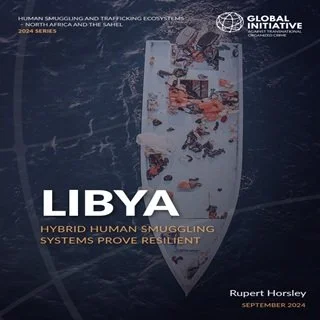By Ahmed Hussain, Ayla Bonfiglio
This report focuses on the nature and dynamics of human smuggling along this Eastern Route from the Horn of Africa across the Red Sea between locations of origin in Ethiopia and points of arrival along the coast of Lahj Governorate in Yemen. It examines the role of smugglers, the services they offer, the financial aspects of the journey, and how migrants perceive their
smugglers. The study is based on 346 surveys with migrants in Lahj, Yemen and 16 with smugglers in Ethiopia.
The Eastern Route is widely regarded as among the most dangerous mixed migration routes originating from the African continent, in terms of migrants' exposure to violence, abuse, and exploitation. This report, based on 346 surveys with migrants in Lahj, Yemen and 16 with smugglers in Ethiopia, focuses on the nature and dynamics of human smuggling along this route between locations of origin in Ethiopia and points of arrival along the coast of Lahj Governorate in Yemen. It examines the role of smugglers, the services they offer, the financial aspects of the journey, and how migrants perceive their smugglers. Additionally, the report delves into the abuses associated with smugglers, migrants’ protection strategies, and the forms of assistance that migrants receive from smugglers. This study was carried out against the backdrop of reduction in recorded migrant arrivals in Yemen, not merely because of the joint military campaign in the Red Sea and anti-smuggling campaigns by Yemeni and Djiboutian coastguards since August 2023, but also owing to decreased access to data collection in key transit locations along this route. The data provide some insight into these dynamics, which is critical to informing the work of humanitarian actors and policymakers, and fundamental for developing interventions that address the vulnerabilities of migrants along this precarious route. The key findings include: • Smugglers played a limited role in influencing respondents’ migration decisions (9%) and route selection (11%) between Ethiopia and coastal departure points in Djibouti or Somalia. Indeed, more than half of the respondents (57%) stated that they were not influenced by anyone in their decision to migrate, indicating that their choice was largely self-motivated rather than driven by persuasion. • Far from being coerced into using smugglers, migrants reported hiring smugglers to make the journey easier (75%) and cheaper (45%), and they were often proactive in initiating contact (85%) themselves. • The vast majority of respondents (95%) employed the services of one smuggler on their journey to Lahj, Yemen. Of these, most (62%) employed them for one part of the journey—likely for the Red Sea crossing. • In contrast to 4Mi data from the Central Mediterranean Route or the Southern Route (towards South Africa), showing smugglers provide a range of services to migrants, the primary service provided by smugglers along this section of the Eastern Route was arranging transit across borders (99%). • On average, 97% of the respondents paid around 300 USD to the smuggler for their services, largely for the sea crossing. With an average of 100,000 migrants crossing annually, this would amount to a smuggling business worth 30 million USD annually, a significant source of income for smugglers operating out of Djibouti. • Over half of surveyed migrants (60%) paid their smuggler in full before starting the journey, which, according to past MMC research, can be a driver of vulnerability, as migrants deplete their resources at the start of the journey and fall victim to smugglers extracting further compensation. • Despite actively seeking to employ smugglers and reporting that smugglers helped them to achieve their migration goal (99%), strikingly, all migrants felt that smugglers intentionally misled them. This finding stands out for its stark contrast with other migration routes, which portray a more mixed picture of misinformation, underscoring the unique and exploitive dynamics of the Eastern Route. • Smugglers were rarely trusted (2%) by migrants as reliable sources of information; with this in mind, few respondents used smugglers as information sources before (12%) and during the journey (28%). • 72% perceived smugglers as perpetrators of abuse in dangerous locations along the route, identifying physical violence (82%), death (68%), and robbery (58%) as the top
dangers. • While smugglers were rarely regarded as trustworthy and were seen as perpetrators of abuse, only 22% of surveyed migrants viewed them as criminals. Indeed, most perceived their smugglers as service providers (64%), highlighting an inherent complexity in migrant-smuggler relationships. The same complexity can be seen in migrants’ strategies for keeping safe along the route: 18% cited hiring smugglers while 1% cited avoiding them to reduce the risk of abuse and crime.
London/Denmark: Mixed Migration Centre, 2024. 24p.





















